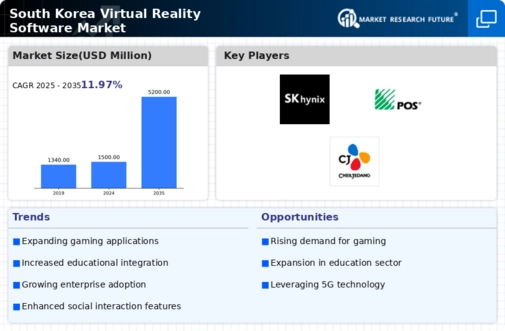The South Korea Virtual Reality Software Market is characterized by its dynamic and fast-evolving landscape, driven by significant technological advancements and growing consumer interest in immersive experiences. The market is influenced by various factors, including increased investments in technology, a rise in demand for VR applications in fields such as gaming, education, healthcare, and entertainment.
The competitive environment is shaped by both established players and emerging startups, all vying for market share. With a focus on enhancing user experience through innovation, companies are developing sophisticated VR solutions that leverage insights from artificial intelligence, machine learning, and high-quality graphics.
The competition is further intensified by the growing adoption of VR technologies across industries, creating opportunities and challenges for market participants.Daewoo Technology has carved out a prominent presence in the South Korean Virtual Reality Software Market, leveraging its extensive technological expertise and experience in software development.
The company has successfully established itself as a key player by focusing on custom solutions tailored to the specific needs of diverse clients within the VR ecosystem. Daewoo Technology benefits from a strong reputation built on its commitment to quality and innovation, which has enabled it to maintain robust partnerships with various tech companies and educational institutions.
The organization's competence in rapid prototyping and user-friendly software design enhances its competitive edge, allowing for swift adaptability to industry trends and consumer preferences. This adaptability, combined with a proactive marketing strategy, positions Daewoo Technology favorably in a competitive market.Dreamface represents another significant entity in the South Korea Virtual Reality Software Market, known for its innovative approaches to VR experiences.
The company specializes in the development of immersive VR applications, focusing on entertainment and simulation sectors. Dreamface has made notable strides in market penetration through a portfolio of engaging products that attract a broad audience, including gaming enthusiasts and educational institutions seeking experiential learning tools.
The company has been active in building strategic partnerships and has engaged in mergers and acquisitions to bolster its capabilities and expand its service offerings. Through these initiatives, Dreamface has established itself not only as a creator of compelling VR content but also as a contributor to the overall growth of the VR landscape in South Korea. Its strengths lie in its strong brand identity, a dedicated development team, and an agile approach to innovation, driving its continued success in a competitive market environment.














Leave a Comment